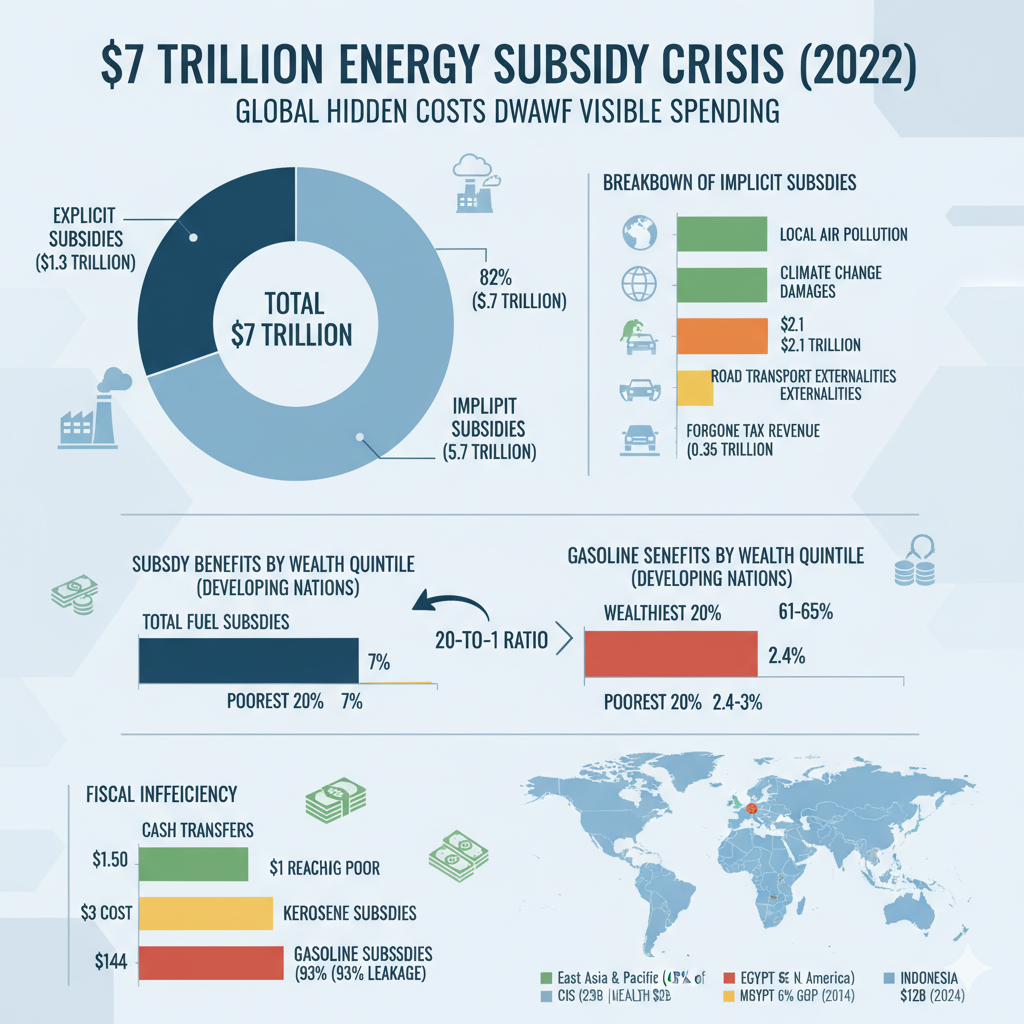Global fossil fuel subsidies reached a staggering $7 trillion in 2022—7.1% of global GDP— International Monetary FundIMFwith explicit subsidies alone exceeding $1.3 trillion. IMF +5 This represents more than governments spend on education worldwide and rivals healthcare expenditures. IMF Yet attempts to reform these fiscally ruinous subsidies continue to fail spectacularly, triggering deadly protests, government collapses, and policy reversals across developing nations. OpenEdition The latest wave of reform attempts in 2024-2025 reveals why: subsidies function as social contracts between citizens and states, and breaking that contract—even when subsidies overwhelmingly benefit the wealthy—carries political costs few governments can survive.
The fundamental paradox driving this crisis is that the richest 20% of households capture six times more subsidy benefits than the poorest 20%, imfimf yet removing subsidies triggers mass protests that topple governments. Chatham House From Nigeria's violent unrest that killed dozens to Kenya's Gen Z uprising that forced parliament's retreat, the political economy of subsidy reform has become one of the most explosive policy challenges facing developing nations.
[Image placement: Protests or fuel station scene]
The hidden costs dwarf the visible spending
When governments and media discuss energy subsidies, they typically reference explicit subsidies—the $1.3 trillion spent undercharging for supply costs in 2022. But this figure captures less than one-fifth of the true cost. The International Monetary Fund's comprehensive 2023 analysis reveals that 82% of the $7 trillion total represents implicit subsidies: costs society pays when fossil fuels are underpriced relative to their environmental damage and foregone tax revenue. IMF +3
Breaking down the $7 trillion reveals the scale of hidden transfers. Underpricing for local air pollution costs society roughly $2.1 trillion annually. Climate change damages add another $2.1 trillion. Road transport externalities like congestion and accidents contribute $1.2 trillion more. The explicit subsidies governments actually budget for? Just $1.3 trillion. Forgone consumption tax revenue accounts for the remaining $350 billion. International Monetary Fundimf
This accounting matters because it exposes how radically markets have been distorted. The IMF found that 80% of global coal consumption was priced at below half its efficient level in 2022. IMF +2 For gasoline and diesel, 60-70% of consumption occurred at prices below 60% of efficient levels. International Monetary Fund These pricing gaps don't just drain treasuries—they actively subsidize environmental destruction while hiding the true costs from citizens and policymakers.
The regional distribution of subsidies reflects both energy consumption patterns and governance failures. East Asia and Pacific accounts for 48% of total subsidies, with China alone responsible for $2.2 trillion (12.5% of Chinese GDP). The Commonwealth of Independent States spends a crushing 23% of regional GDP on subsidies, while the Middle East and North Africa devotes 19% of regional GDP. In contrast, Europe and North America spend roughly 3% of GDP—still substantial but far more sustainable. imf +2
For developing nations, these percentages translate to brutal fiscal tradeoffs. Nigeria spent $5.9 billion on fuel subsidies in 2024—48% of projected oil revenue— Bloombergwhile the health budget received approximately $2 billion. World Resources Institute Egypt's subsidies consumed 6% of GDP in 2014, equivalent to 22% of the government budget. Chatham House +4 Indonesia budgeted $12 billion for energy subsidies in 2024, Antara News enough to transform its education and healthcare systems. Smeru Pakistan's circular debt in the power sector reached $9.36 billion as of May 2024, with cumulative electricity sector losses exceeding $19 billion.
Subsidies as upward wealth redistribution
The distributional impact of energy subsidies reveals them as one of the most regressive forms of government spending globally. Across developing countries, IMF research consistently shows the wealthiest quintile receiving 43-47% of total fuel subsidy benefits while the poorest quintile captures a mere 7%. Earth.Org For gasoline subsidies—the most regressive category—the disparity explodes: the top 20% receive 61-65% of benefits while the bottom 20% receive just 2.4-3%. IEA +3
This translates to a 20-to-1 ratio for gasoline, meaning wealthy households receive twenty times the subsidy value of poor households. imfimf The mechanism is straightforward: subsidies provide benefits proportional to consumption, and wealthy households consume vastly more energy. They own private vehicles, live in larger homes requiring more heating and cooling, travel more frequently, and use energy-intensive appliances. Poor households often lack electricity connections entirely—27% in developing countries—and rarely own vehicles.
Country-specific data reinforces this pattern with stark precision. In Indonesia's 2011 study, the wealthiest decile consumed 40% of subsidized gasoline while the poorest decile used less than 1%. Two-thirds of poor households consumed no gasoline at all, yet the subsidies consumed 20% of Indonesia's annual budget. MediumScienceDirect Egypt's 2013 pre-reform analysis found the wealthiest 20% received 46% of subsidy benefits compared to just 9% for the poorest quintile. Chatham HouseWorld Resources Institute In urban areas, this gap widened to an eight-to-one ratio. World Resources Institute
"To transfer one dollar to the poorest 40% of households via gasoline subsidies costs the government fourteen dollars, with 93 cents of every dollar leaking to wealthier households." — IMF Working Paper, 2015 Medium
This fiscal inefficiency makes subsidies perhaps the worst possible tool for poverty alleviation. Targeted cash transfers cost roughly $1.50 per dollar delivered to poor households (33% administrative overhead). Gasoline subsidies cost $14 per dollar delivered (93% leakage rate). Even the least regressive fuel—kerosene—still costs $3 per dollar reaching the poorest 20%. Mediumimf

The brutal politics of reform leave bodies in the streets
The wave of subsidy reform attempts in 2024-2025 has been marked by violence, death, and dramatic government retreats. Nigeria's experience captures the political volatility. When President Bola Ahmed Tinubu abruptly removed fuel subsidies in May 2023, prices exploded from 185 naira per liter to 1,025 naira—a 454% increase. afrobarometerAfrobarometer Combined with currency devaluation, this triggered massive protests in August 2024 that left at least 19 people dead as police fired live ammunition at demonstrators. Al JazeeraAfrobarometer An Afrobarometer survey found 85% of Nigerians disapproved of the subsidy removal, with 58% demanding reinstatement even if it meant cutting healthcare or education spending. afrobarometerAfrobarometer
Kenya's Gen Z-led uprising proved even more explosive. The Finance Bill 2024, which included tax increases alongside earlier fuel subsidy removal, sparked protests organized via TikTok and X under #RejectFinanceBill2024. On June 25, 2024, protesters stormed Parliament and set the building ablaze. Security forces killed at least 60 people, with some reports exceeding 120 deaths across the protest period. President William Ruto withdrew the bill the next day, but anniversary protests in June 2025 killed 16 more people. WikipediaWikipedia The movement was notable for being "leaderless, partyless, tribeless"—organized entirely through social media by young people facing economic hardship after Ruto broke campaign promises to "hustlers." Internationalsocialist
Egypt proceeds far more cautiously, haunted by the ghost of the 1977 Bread Riots triggered by IMF-mandated subsidy cuts. Xinhua +2 When the government quadrupled subsidized bread prices in June 2024—the first increase in 30 years—MPs submitted urgent briefings calling bread subsidies "a matter of national security." The NationalThe Arab Weekly With 70 million people (60% of the population) depending on subsidized bread, and Egyptians consuming 150-180 kg annually compared to the 70-80 kg global average, the symbolic and material power of bread subsidies cannot be overstated. Fitch SolutionsXinhua The government has implemented three fuel price increases in 2024 and committed to eliminating fuel subsidies by Q1 2026 under IMF pressure, Sada Elbalad +2 but moves incrementally to avoid triggering unrest. The Arab Weekly
Indonesia represents a different failure mode: the perpetual subsidy trap. Despite reform attempts in 2014-2015 that temporarily eliminated gasoline subsidies and saved $15.6 billion, subsidies gradually crept back. By 2022, they surged to $23.56 billion during the energy crisis. Smeru The 2024 budget allocated $12 billion— Antara Newshardly austere—due to what Finance Ministry officials describe as "political economy complexity" involving food price pressures, politicians' electoral concerns, and formidable fossil fuel lobbying. Smeru
The singular success story remains Morocco's 2012-2015 reform, which reduced subsidy spending from $5.8 billion to $1.1 billion over three years without triggering unrest. IEA +3 The keys to success: gradual phased implementation rather than shock therapy, strong public communication campaigns, maintaining subsidies for cooking gas used by the poor while eliminating those on gasoline benefiting the wealthy first, expanded social protection programs as compensation, and visible reinvestment in renewable energy projects creating jobs. imf +2 The reform required three years of careful management, robust political commitment from the highest levels, and occurred during relatively favorable economic conditions—luxuries most governments attempting reform lack.
"The biggest challenge of increasing energy prices is the immediate impact on the livelihoods of citizens. Regrettably, the benefits of subsidy reform to the wider population are in most cases not immediately tangible." Chatham House — IMF Fiscal Monitor, April 2025 Chatham House +2
Environmental catastrophe hidden in plain sight makes climate goals mathematically impossible
The climate implications of fossil fuel subsidies are staggering and render the Paris Agreement goals unattainable without reform. IMF research demonstrates that full subsidy reform would reduce global CO2 emissions by 43% below baseline levels in 2030—a reduction equivalent to removing 1,000 coal-fired power plants or taking 7.2 billion cars off the road. IMF This 43% reduction would place the world on track to limit warming to 1.5-2°C, the Paris Agreement target. IMF +3 Yet subsidies continue rising, projected to reach $8.2 trillion by 2030. International Monetary FundIMF
The environmental costs embedded in implicit subsidies reveal the true damage. Beyond the direct fiscal burden, fossil fuel subsidies caused 4.5 million premature deaths from air pollution in 2019, with 60% attributable to fossil fuels rather than other pollution sources. Full price reform would prevent 1.6 million premature deaths annually— IMFa health dividend equivalent to curing multiple major diseases simultaneously. imf +3 Local air pollution costs alone account for roughly $2.1 trillion of the $7 trillion total, with climate damages adding another $2.1 trillion. International Monetary Fund
The Production Gap Report 2025 from the Stockholm Environment Institute and UNEP reveals governments plan to produce 120% more fossil fuels in 2030 than consistent with limiting warming to 1.5°C, and 77% more than consistent with 2°C. International Institute for Sustainable Development This production explosion is actively subsidized: governments simultaneously commit to Paris Agreement targets while spending trillions to make fossil fuels artificially cheap.
The COP28 agreement in Dubai marked the first explicit mention of "transitioning away from fossil fuels" in UN climate negotiations, along with commitments to phase out "inefficient" subsidies. United States Institute of Peace +3 However, the "inefficient" qualifier provides a massive loophole with no universally endorsed definition. ODI The Netherlands-led Coalition on Phasing Out Fossil Fuel Incentives (COFFIS) has attracted 17+ countries committing to publish subsidy inventories, Government of the NetherlandsTable.Media but this represents a fraction of global subsidizers. China, the United States, Russia, India, and the EU—the top five subsidizers accounting for over $4 trillion combined—face enormous political barriers to reform despite their climate commitments.
The fiscal opportunity cost is equally dramatic. Full price reform would raise $4.4 trillion in government revenues by 2030 (3.6% of global GDP). For 121 emerging market and developing countries, reform would generate $3 trillion—broadly matching their additional spending needs for Sustainable Development Goals including universal healthcare, quality education, and climate adaptation. imf +3 Partial reform closing half the pricing gap would still raise $2.8 trillion (64% of full reform revenues).
Consequences of inaction compound the crisis
The subsidy crisis intensifies along multiple dimensions simultaneously. Fiscally, developing nations divert enormous resources from productive investments to subsidize overconsumption, often spending more on subsidies than they receive in total bilateral foreign aid. Fifty-nine of 96 countries tracked spend more on energy subsidies than the aid they receive, with particularly stark ratios in Central Asia, Latin America, and parts of sub-Saharan Africa. This crowds out spending on education, healthcare, infrastructure, and climate adaptation—the very investments that could break cycles of poverty and vulnerability. Chatham House

Politically, failed reform attempts erode trust in governments and international institutions. When the IMF conditions loans on subsidy cuts that trigger deadly protests, publics see technocratic elites imposing pain while political classes continue living in luxury. OpenEdition Nigeria's subsidies were "notorious for their opacity and graft" with "billions of dollars lost through corrupt practices," The Conversation yet citizens don't trust governments will use savings productively. Daily News EgyptThe Conversation This trust deficit makes future reform attempts even more treacherous.
Environmentally, every year of delay locks in higher emissions trajectories and accelerates climate damage that will cost trillions more to address. The IMF estimates that by 2030, underpricing environmental costs will represent 92% of total subsidies as explicit subsidies gradually decline but implicit costs accelerate. International Monetary Fund Coal—responsible for 30% of subsidies despite being only 27% of energy consumption—remains so heavily subsidized that 80% of global consumption occurs at below half its efficient price. IMF +2 Each year this continues, the atmosphere accumulates more CO2, pushing climate tipping points closer.
Distributionally, subsidies function as massive upward wealth transfers disguised as social protection. With wealthy households capturing six to twenty times more benefits than poor households depending on fuel type, subsidies actively increase inequality while draining resources that could fund genuinely progressive social programs. imf The $14 leakage cost per dollar reaching the poorest 40% via gasoline subsidies represents perhaps the most inefficient social spending in human history. Mediumimf
The traditional approach to energy subsidies—universal pricing below cost, justified as social protection—has failed comprehensively. It destroys government budgets, benefits the wealthy disproportionately, kills millions through air pollution, makes climate goals impossible, and triggers deadly unrest when reform is attempted. Chatham House +3 Yet the political economy dynamics make reform extraordinarily difficult without careful design, robust communication, genuine social protection, and political commitment sustained over years. OpenEdition
Morocco's experience demonstrates reform is possible but requires acknowledging subsidies as political issues, not merely technical ones. World Bank Governments must rebuild trust before demanding sacrifice, protect the genuinely vulnerable while eliminating benefits for the wealthy, communicate clearly and honestly, and reinvest savings visibly in benefits citizens can see and feel. IEA +2 Without these elements, the $7 trillion crisis will continue metastasizing, consuming resources desperately needed for development while accelerating toward climate catastrophe. The question is no longer whether traditional approaches are failing—the bodies in Nigeria and Kenya's streets provide that answer—but whether governments can muster the political skill and courage to design reforms that succeed where so many have failed.
